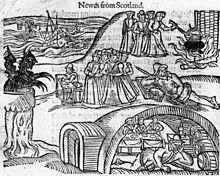North Berwick Witch Trials
The witch trials of North Berwick ( North Berwick witch trials ) ranged starting in 1590 over two years. About 70 people were charged.
prehistory
They went back to a witch trial in Copenhagen . In this trial Anna Koldings was charged with witchcraft guilt that Princess Anna did not go directly to the wedding with King James VI. could travel to Scotland, but had to stop in Oslo after severe storms. Anna Koldings confessed under the torture that she and five other women, among them Mail, the wife of the mayor of Copenhagen, had caused the storms by magic. Anna Koldings was found guilty and burned at Kronborg Castle in 1590 . When King James VI. learned of the trial, he also set up a court in North Berwick to investigate these incidents.
The connection to Scotland was made by the maid Gillis Duncan (or Geilis Duncan). She worked for David Seaton in Tranent . Allegedly, Duncan developed healing powers and snuck out of the house at night. She couldn't explain these skills and behavior to Seaton, so he had her tortured. Duncan confessed to being a witch under torture and accused other men and women of witchcraft.
According to the contemporary Newes from Scotland pamphlet of 1591, she said:
“Agnes Sampson the eldest witch of them all, dwelling in Haddington; Agnes Tompson of Edenbrough; Doctor Fian alias John Cuningham, master of the school at Saltpans in Lowthian, of whose life and strange acts you shal hear more largely in the end of this discourse. These were by the said Geillis Duncane accused, as also George Motts wife, dwelling in Lowthian; Robert Grierson, skipper; and Jannet Blandilands; with the potter's wife of Seaton: the smith at the Brigge Hallis, with innumerable others in those parts, and dwelling in those bounds aforesaid; of whom some are already executed, the rest remained in prison to receive the doome of judgment at the Kinges Majesties will and pleasure. "
“Agnes Sampson, the oldest witch of all, lives in Haddington; Agnes Tompson of Edenbrough; Doctor Fian aka John Cuningham, director of the Saltpan School in Lowthian, whose life and strange actions will be heard more at the end of this discourse. These were indicted by Geillis Duncane, as well as by George Mott's wife, who lived in Lowthian; Robert Grierson, skipper; and Jannet Blandilands; with Seaton's potter-wife: the smith at the Hallis brig, with innumerable others in those parts, and dwelling in those abovementioned borders; some of whom have already been executed, the rest remained in prison to await the king's verdict under the roof of the court. "
accused

The confessions were obtained through torture at Old Tolbooth, in the City of Edinburgh . The most important evidence of the events is a pamphlet in the Newes from Scotland from 1591, to which King James VI. when he published his work on witch hunts Daemonologie in 1597.
The main people charged in these trials were:
- Agnes Tompson, also Agnes Sampson
- Doctor Fian (John Cunningham)
- Barbara Naper
- Ewphame Mecalrean (Euphemia Maclean)
- Geillis Duncan
- Robert Grierson
- Lennit Bandilandis
- The Porter's wife of Seaton
- The Smith of Bridge Hallis
- The Wife of George Mott
- Alanis Muir
- as well as others
More than a hundred suspected witches were arrested in North Berwick. Many were tortured to have met the devil in church that night. Furthermore, they would have devoted themselves to evil, intended to poison the king and other members of his household, and tried to sink the king's ship in a storm.
Major suspects include Agnes Sampson , a respected elderly woman from Humbie, and Dr. John Fian, schoolmaster and scholar in Prestonpans . Both denied the charges and were subjected to severe torture until they confessed.
Barbara Naper was also seriously accused. It is said to have caused the death of Archibald Douglas, 8th Earl of Angus , through witchcraft . Archibald is said to have died of an illness so strange that there could be no cure.
Reviews
In his play Macbeth , William Shakespeare adopted many components of the processes. Heavily influenced by the published incidents, the play was published a few years after the demonology of King James I.
The doom metal band Cathedral from Coventry released the song: "North Berwick Witch Trials" on their 2005 album The Garden of Unearthly Delights .
In the novel series Highland saga of Diana Gabaldon is a character who is condemned as a witch and punished Geillis Duncan . In the television adaptation Outlander by Ronald D. Moore will of Lotte Verbeek shown.
Judy Chicago dedicated an inscription to Agnes Sampson on the triangular floor tiles of the Heritage Floor of her installation The Dinner Party . The porcelain tiles labeled with the name Agnes Sampson are assigned to the place with the place setting for Petronilla de Meath .
Individual evidence
- ↑ Kjøbenhavn i Aarene 1536-1660, første del. In: eremit.dk. Retrieved December 10, 2017 (Danish).
- ↑ a b Translations and Reprints from the Original Sources of History . University of Pennsylvania Press, 1912, pp. 19 ( books.google.com ).
- ^ Newes from Scotland, 1591, as reprinted in Pitcairn's Criminal Trials in Scotland, vol. 1, pt. 2, pages 215-223.
- ↑ a b Demonology of King James I Projekt Gutenberg, accessed December 10, 2017
- ↑ B. Ankarloo, S. Clark, EW Monter: Witchcraft and Magic in Europe . Page 79
- ↑ King James: Daemonology. A Critical Edition. In Modern English. 2016 , ISBN 1-5329-6891-4 , p. 107.
- ^ Brooklyn Museum: Agnes Sampson. In: brooklynmuseum.org. Retrieved December 10, 2017 .
